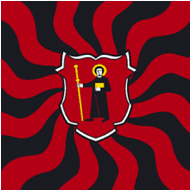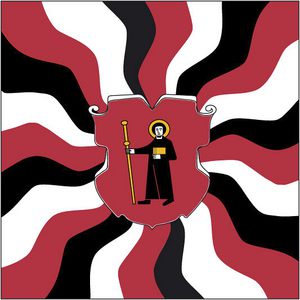![[Flag of Glarus]](../images/c/ch-gl.gif) image
by António Martins
image
by António Martins

Last modified: 2025-11-15 by martin karner
Keywords: switzerland | glarus | german |
Links: FOTW homepage |
search |
disclaimer and copyright |
write us |
mirrors
Description of the Flag
Gules St. Fridolin guardant Proper habited Sable garnished of the First and nimbed Or carrying in his
dexter hand a staff and in his sinister a Bible of the Fourth.
Christopher Southworth
On a red field, St. Fridolin walking towards the hoist and turning to
face the viewer; his head and hands are white; hair, shoes and
vestments are black; his halo (nimbus), staff and Bible are yellow or
gold. In practice the image and stance of St. Fridolin has varied
considerably. Sometimes he wears a hat; sometimes his Bible is red;
sometimes his vestments are brown; sometimes he carries a pilgrim's
bag; and from about 1437 to 1578 his plain pilgrim's staff was
replaced by an abbot's or bishop's crozier. The modern, very stiff
pose with sickly white face and hands was created by Ernst Keller and
officially adopted in 1959.
T.F. Mills, 17 October 1997
Symbolism of the flag
St. Fridolin is the only saint to be depicted on a cantonal banner.
He is said to have christianised the area.
T.F. Mills, 17 October 1997
History of the Flag
There is some question whether St. Fridolin, who allegedly lived in
the 6th century, ever existed. According to legend he was a Scottish
or Irish missionary (under the direction of St. Columban – not to be
confused with Columba) who evangelised the German tribes with the
blessing of the king of the Francs who had just converted to
Christianity. He founded the monastery of Sackingen (umlaut on the
a) on an island in the Rhine river, which ruled Glarus. Fridolin had
evanglised Glarus after the founding of the monastery, and a Frankish
count by the name of Urs bequeathed Glarus to the monastery in his
last will. His brother Landolf contested the will, but Fridolin
brought Urs back from the dead to prove his case. The great distance
from Sackingen meant that Glarus enjoyed considerable independence,
and by 1289 the town had its own seal. The seal showed a cleric
kneeling and praying to the Virgin Mary. This might actually have
been the prototype for St. Fridolin, whose first documented
appearance on the Glarus flag is in 1388 (at the battle of Nafels).
From about that time to 1792, the Glarus banner was always topped
with a white Schwenkel. Real or fictitious, Fridolin remains the
patron saint of Glarus. Glarus formally became a sovereign state
in 1323 and joined the Swiss confederation in 1352.
T.F. Mills, 17 October 1997
The current symbols date from 1959. Until 1792, a white streamer adorned the
banner.
Source: Angst (1992), "A Panoply of
Colours: The Cantonal Banners of Switzerland and the Swiss National Flag"
Phil Nelson, 14 October 1998
As T.F. Mills points out above, the image and stance of St. Fridolin, the heraldic figure of the Glarus
flag, has varied considerably throughout the centuries. Without regulation practically every flag maker
and painter was free to design it according to his ideas.
The roots towards modern regulations were laid in the 19th century, with the stained cantonal window panes
in the old canton's chamber in the national parliament in Bern. The window pane of Glarus, made in 1861 by
Ludwig Stantz (He recorded Fridolin's depiction of the oldest seal of Glarus and chose the colours himself),
was taken as a template by Rudolf Münger in 1931 (in the publication of the Federal Chancellery about
the Swiss arms and control stamps [c9h31], see
picture), in terms of colours, not of representation. Münger's
version has the usual black coat, natural skin colour, black staff, red Bible with golden/yellow edge,
still the green bag (Stantz' green bag was citicized widely, because he introduced a new tincture without
historical reference) and black sandals with green thongs.
On 30 October 1941 the cantonal government of Glarus issued the very first legal regulation of the emblem.
It adopted Münger's drawing, but changed some colours: The staff was now golden/yellow, the bag was
silver/white, the sandals golden/yellow with black thongs (picture).
If the staff looks too short on the flag, that's because the depiction was taken from the coat of arms,
where there wasn't more space for it (picture).
This version lasted until 25 June 1959, when the government decreed a completely new and modernized
version which is still in use today. The stylized version, drawn by Ernst Keller, leaves out all the
extraneous things, as people felt at the time. Hat and bag are gone, the sandals replaced by shoes, the
Bible is golden/yellow. The natural skin colour was changed to white, which got some criticism because of
its unnatural look (see flag on this page). The distant effect has been improved.
Sources:
Wappen und Fahnen der Schweiz (1991), [mue91]
Die Farben und Fahnen der Schweizerischen Eidgenossenschaft und der Kantone (1942), [mro42]
Die Wappen der Schweizerischen Eidgenossenschaft und der Kantone (1931), [c9h31]
Martin Karner, 21 November 2023
![[Colour Flag GL]](../images/c/ch-gl_56.gif) image
by Ole Andersen
image
by Ole Andersen
Simple rectangular cantonal flag, as shown in Kannik (1956) (So-called
colour flag [Farbenfahne in German]).
See also huissier's plaque (Weibelschild) from 15th century
with coat of arms and cantonal colours (source: [mue91]).
Ole Andersen/Martin Karner
See also: STATE COLOURS in Dictionary of Vexillology
Flaggen, Knatterfahnen and Livery Colours |
![[Knatterfahnen]](../images/c/ch-gl_kf.gif)
|
Flaggen are vertically hoisted from a crossbar in the manner of gonfanon, in ratio of about 2:9, with a swallowtail that indents about 2 units. The chief, or hoist (square part) usually incorporates the design from the coat of arms – not from the flag. The fly part is always divided lengthwise, usually in a bicolour, triband or tricolour pattern (except Schwyz which is monocolour, and Glarus which has four stripes of unequal width). The colours chosen for the fly end are usually the main colours of the coat of arms, but the choice is not always straight forward.
Knatterfahnen are similar to Flaggen, but hoisted from the long side and have no swallow tail. They normally show the national, cantonal or communal flag in their chiefs.
Željko Heimer, 16 July 2000
See also: HANGING FLAG, VERTICALLY HOISTED FLAG, LIVERY COLOURS in Dictionary of Vexillology
A decorative flag of Glarus canton with flame-design (56x52 cm), early 20th century
(reverse side). The flag is fixed on a wooden staff. The flag
seems to be made before 1941, the year when the cantonal government issued the first regulation for the
design of the figure of St. Fridolin (See "History of the flag" above).
Martin Karner, 9 March 2024
![[Flag of Glarus canton]](../images/c/ch-gl_fla.jpg) image located by
Clayton Horner
image located by
Clayton Horner
This postcard is circa 1910s and shows a flag of Glarus canton, Switzerland. I am not
sure if there is a mistake on the postcard, or if it is historical.
Clayton Horner, 29 January 2014
At the beginning of the 20th century, flamed flags were still in use, with the white cross replaced by a
(baroque) shield in the centre of the flag. These decorative flags had been used
until WWII and then somewhat forgotten in preference of the current cantonal flags.
[Today they are being produced again, see below]
Pascal Gross, 30 June 2002
 image #1 (wrong colours) located by Russ Adams
image #1 (wrong colours) located by Russ Adams
"At the beginning of the 20th century, flamed flags were still in use, with the white cross
replaced by a (baroque) shield in the centre of the flag. These decorative flags had
been used until WWII and then somewhat forgotten in preference of the current cantonal flags."
(Pascal Gross, 30 June, 2002). The unidentified flag of Glarus canton, Switzerland, appears to be a flamed
"war flag" version of the canton flag.
I have also located a currently marketed flamed version of the Glarus canton flag (#1).
The flames on the postcard shown above are actually closer in configuration to the
modern flamed flags shown on the FOTW page [where the above quote
by Pascal Gross comes from], incorporating white flames into the design. [The colouring of the flames on
image #1 is not correct. The cantonal colours are red, black and white, which should be reflected in the
colours of the flames, as on image #2.]
Nevertheless, it appears likely that the flag on the postcard is a rendition of the pre-WW2 Glarus canton
war flag.
Russ Adams, 23 February 2014
 image #2 located by Russ Adams
image #2 located by Russ Adams
And here is another commercially available version ( > choose Glarus canton) (#2), this one incorporating white in the flame design.
Russ Adams, 24 February 2014
See also:
logo.jpg)
gla-r.jpg)
gla-s.jpg) images located by Martin Karner (8 May 2024 | source)
images located by Martin Karner (8 May 2024 | source)
 image located by Martin Karner
image located by Martin KarnerCockade for the cantonal troops' headgear (regulation from 1898, size: ca. 35 mm, reverse side).
Martin Karner, 14 March 2025
See also: Cockades (Swiss Army)